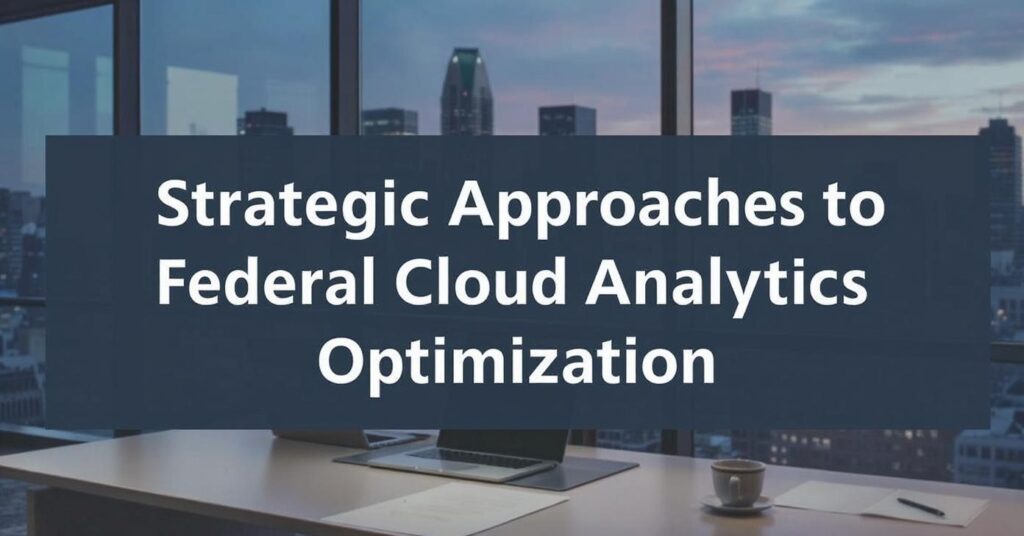The growing reliance on data to make informed decisions has placed federal agencies under pressure to modernize their IT infrastructures. Cloud adoption is at the heart of this modernization, providing agencies with scalability, cost-efficiency, and agility. However, managing and analyzing vast datasets in a secure, compliant, and performance-driven environment presents unique challenges. To navigate these challenges, federal agencies must embrace best practices for Federal Cloud analytics.
Federal cloud analytics refers to the methods and technologies employed by government bodies to analyze large datasets in cloud environments. With the increasing digitization of government services, the ability to harness data through analytics has become essential for improving public services, enhancing national security, and driving policy decisions.
Ensure Compliance and Security First
Security and compliance are non-negotiable in the federal space. Federal agencies must adhere to stringent regulatory frameworks, including FedRAMP (Federal Risk and Authorization Management Program), FISMA (Federal Information Security Management Act), and NIST (National Institute of Standards and Technology) standards.
One of the best practices for federal cloud analytics is choosing a cloud service provider (CSP) that meets or exceeds these federal standards. Agencies should look for CSPs with FedRAMP certification and the ability to support data encryption both at rest and in transit. Additionally, the implementation of Identity and Access Management (IAM) ensures that only authorized personnel access sensitive data.
Regular security audits, incident response planning, and continuous monitoring are essential strategies. These measures protect against data breaches and ensure alignment with federal cybersecurity mandates. Cloud analytics environments must also support audit logs to trace user activity and maintain accountability.
Data Governance and Lifecycle Management
Another crucial component of best practices for federal cloud analytics is robust data governance. With increasing data sources—ranging from IoT sensors to citizen services—agencies must establish clear policies on data collection, storage, usage, and disposal.
A well-structured data lifecycle management plan ensures data is accurate, accessible, and secure throughout its lifecycle. Metadata tagging, data cataloging, and lineage tracking help identify data ownership and usage, allowing for easier compliance and efficient analysis.
Implementing role-based access control (RBAC) further strengthens governance. It ensures users only access data necessary for their role, reducing the risk of misuse. Agencies must also routinely review their data assets to eliminate redundancy and outdated datasets.
Choose the Right Analytics Tools and Platforms
Federal agencies often deal with diverse data formats and high-volume workloads. Selecting the appropriate analytics platform is central to efficient and effective cloud analytics. Tools that support real-time processing, machine learning integration, and customizable dashboards offer greater value.
Modern cloud-based platforms like Amazon Web Services (AWS) GovCloud, Microsoft Azure Government, and Google Cloud for Government provide scalable environments tailored for federal workloads. These platforms come equipped with built-in analytics services such as data lakes, AI/ML tools, and interactive dashboards.
Another best practice for federal cloud analytics is leveraging open-source and interoperable tools where possible. They allow for flexible integration, reduce vendor lock-in, and often align with the federal government’s push toward open data initiatives.
Establish Strong Data Integration Pipelines
Seamless integration of data from multiple sources is essential for meaningful analytics. Federal agencies must develop robust ETL (Extract, Transform, Load) pipelines to consolidate structured and unstructured data from disparate systems.
Implementing automated data pipelines enhances accuracy, reduces manual errors, and ensures real-time data availability. Data should be normalized, deduplicated, and enriched before entering analytics platforms. Integrating APIs, message queues, and stream processing tools like Apache Kafka enables agencies to process data in motion for timely insights.
Additionally, adopting standardized data models simplifies integration across departments. This enables data interoperability and facilitates cross-agency collaboration—a growing need in interconnected federal operations.
Invest in Training and Talent Development
Even the most sophisticated tools are ineffective without skilled personnel to operate them. One of the most overlooked best practices for federal cloud analytics is upskilling the federal workforce. Agencies must invest in training programs to build cloud and analytics competencies among their teams.
Certifications in cloud platforms (e.g., AWS Certified Data Analytics, Microsoft Azure Data Engineer) and tools (e.g., Tableau, Power BI, Apache Spark) can bridge the skill gap. Encouraging collaboration between data scientists, IT administrators, and policy makers ensures that analytics insights are actionable and aligned with agency missions.
Workforce development should also include cybersecurity training. With data breaches on the rise, every team member must understand their role in maintaining cloud security.
Implement a Cloud Cost Optimization Strategy
Federal agencies must adhere to tight budgets and ensure cost-efficiency in their cloud operations. Analytics workloads can consume significant resources, especially when dealing with high-volume or real-time processing.
Cost optimization involves right-sizing cloud resources, employing auto-scaling where possible, and using tiered storage solutions. Agencies should implement cost monitoring tools to track usage patterns and forecast future spending.
Using serverless computing models—such as AWS Lambda or Azure Functions—can also optimize resource allocation. These models allow analytics jobs to run only when needed, reducing unnecessary expenditures.
Enable Data Democratization with Self-Service Tools
Agencies that adopt self-service analytics tools empower their employees to derive insights without relying solely on IT teams. Tools such as Microsoft Power BI, Tableau, and Qlik enable users to create dashboards and reports through intuitive interfaces.
This democratization increases productivity and allows departments to make data-driven decisions faster. It also enhances transparency and accountability, aligning with federal mandates for open government.
However, self-service capabilities must be implemented alongside governance controls. Data access permissions, data quality standards, and compliance monitoring should remain intact to avoid misinterpretation or misuse of data.
Foster Inter-Agency Collaboration
Federal challenges often span multiple departments—from disaster response to public health. Therefore, one of the evolving best practices for federal cloud analytics is fostering collaboration across agencies through secure data sharing.
Cloud-based collaboration tools and secure data exchange platforms enable agencies to work jointly on large-scale initiatives. Sharing anonymized data sets across agencies can enhance predictive analytics, help in risk mitigation, and optimize public resources.
Data exchange should be governed by clearly defined data sharing agreements, compliance protocols, and cybersecurity measures. Platforms supporting multi-tenant data access and audit trails help maintain trust among collaborators.
Adopt a Continuous Improvement Mindset
Federal cloud analytics is not a one-time project—it is a continuous journey. Agencies must regularly review their analytics strategies, measure outcomes, and adapt to changing technologies and regulatory requirements.
Continuous improvement entails adopting emerging technologies such as AI-driven analytics, natural language processing, and augmented analytics. These innovations allow agencies to extract deeper insights from data with minimal manual effort.
Additionally, soliciting feedback from stakeholders helps refine analytics use cases and enhance user satisfaction. Agencies should also benchmark their analytics performance against peer organizations and industry standards to identify areas of improvement.
Prioritize Ethical Use of Data
In a data-driven federal environment, ethical considerations must not be overlooked. The analytics initiatives must align with federal values such as transparency, privacy, and fairness.
Agencies should ensure that algorithms used in analytics are free from bias and that AI-driven insights do not perpetuate discrimination. Establishing ethical review boards and implementing bias detection tools are effective ways to uphold ethical standards.
Increased transparency through explainable AI and open-source algorithms helps citizens trust that federal data initiatives serve the public interest.
Read Full Article : https://bizinfopro.com/whitepapers/it-whitepaper/best-practices-for-federal-cloud-analytics/
About Us : BizInfoPro is a modern business publication designed to inform, inspire, and empower decision-makers, entrepreneurs, and forward-thinking professionals. With a focus on practical insights and in‑depth analysis, it explores the evolving landscape of global business—covering emerging markets, industry innovations, strategic growth opportunities, and actionable content that supports smarter decision‑making.



